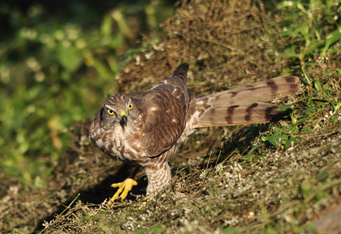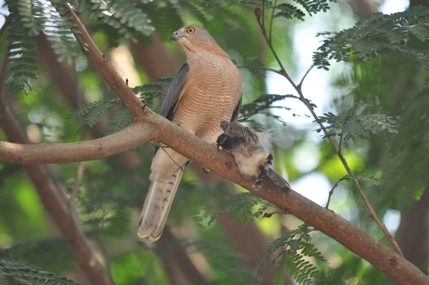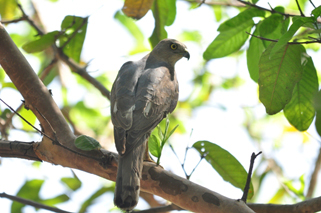Shikra Pairing
-Ajay Gadikar
This is an article about a pair of Shikra (Accipiter badius), birds that used to reside at the Bio-diversity nursery at the forest campus in Indore. This beautiful bird of prey is a resident species of India and is easily seen near human habitation apart
from forested areas.
I have been observing a pair of Shikra since two years, but last year only I was able to watch closely their breeding ecology. Their breeding period starts from February-March. The first thing that you notice about it is, they become very noisy during
this period, their occasional calls become very regular and they can be heard from a great distance as well.
Last year I saw their courtship behaviour just at the start of month of March, the same time when the Indian grey hornbill, rose ringed parakeets, coppersmith barbet all were also indulged in their breeding rituals. I must tell you that the Male and female
of this species are easily distinguishable, the Male has orange red eyes while the female has yellow eyes, also the female is slightly bigger in size.
Female shikra
In the breeding behaviour of the Shikra, the Male brings some catch (food) and offers it to the female. Once I have seen him offering a lizard to the female. The female came flying towards the Male and immediately accepted the feed and started to eat
it. As she ate the feed the Male tried to mount over and they started mating. They were making quite a noise as they were mating. The same phenomenon was seen twice when the male has offered one or other kill to the female.

Shikra male
Generally the kills are of small birds, squirrels, juveniles of Pigeon and dove. The same week I saw the female carrying small twigs to the nearby tree, I understood that she must be preparing the nest. The nest was on the higher canopy of the tree (almost
at a height of 10 meter). It was impossible to photograph the nest, but from a forest guard residence roof I was able to observe the behaviour closely. The nest seemed to have been built of thin sticks and twigs, more or less like a crow nest but a little
smaller than that, I also saw the female putting some green leaves inside the nest.
One week later I used to see the female mostly confined near the nest. Might be she had laid the eggs and was incubating the eggs. The Male used to bring the food daily and make calls to the female; she immediately leaves the nest and takes the feed.
The Male and female chase any intruder seen near the nest like the House Crow, Greater Coucal and the Rufous Treepie.

Shikra with a kill
Watching Shikra hunting down its prey is always fascinating. It is worth mentioning a particular event when my son and I watched how a Male Shikra bird catch a juvenile Red vented Bulbul. It was quite a hide and seek game. As I was watching a juvenile
Red vented Bulbul chick being fed by its parents inside a canopy, a male Shikra arrived. The parents of the juvenile immediately moved away and keptwatching from a distanc, while the juvenile kept himself hiding inside the canopy.
The Shikra was sensing that prey is there, but was not able to locate the exact position. We were placed in such a position that we can watch both the prey and the predator. It was a long waiting game; the juvenile was not at all making any movement.
The Shikra then changed its position and flew a bit near on an electric wire, now it seemed that the Shikra was able to locate its prey but he was aware that we were also watching the scenario, so he waited for a while, after a few minutes the Shikra moved
in a flash, cleanly he picked up the juvenile and flew on a nearby tree. As it happened both the parents Red vented Bulbul immediately flew where the Shikra had gone and started making noise and tried to disturb the Shikra keeping a safe distance from him.
It continued for around 10 minutes, the juvenile was alive but was in firm grip of the shikra’s talons, after ten minutes the Shikra who was very watchful and sensing what is happening around him, suddenly changed his stance and killed the juvenile and then
stared to tear out its feathers. The parent’s desperate attempt to save their chick was in vain and they left the place. Later the male shikra took the feed to the nest and offered it to the female.

Male shikra with the catch
After some days I saw that the pair has raised two chicks, now the male and female both started bringing the food for the chicks. The chicks grew rapidly; it took almost 4 weeks for them to take their first flight, later
they started to take flight on the nearby branches and fight for their share whenever the parents bring feed for them.
The crows were chased frantically if they tried to come near the tree, within 8-10 days the fledglings started to fly hard and move away with their parents to some unknown location. The Shikra parents had raised the chicks
and given them the wings to venture in the wild.

Female shikra
Ajay Gadikar is an observational naturalist from Indore. He can be contacted at ajay.gadikar@lmsin.com